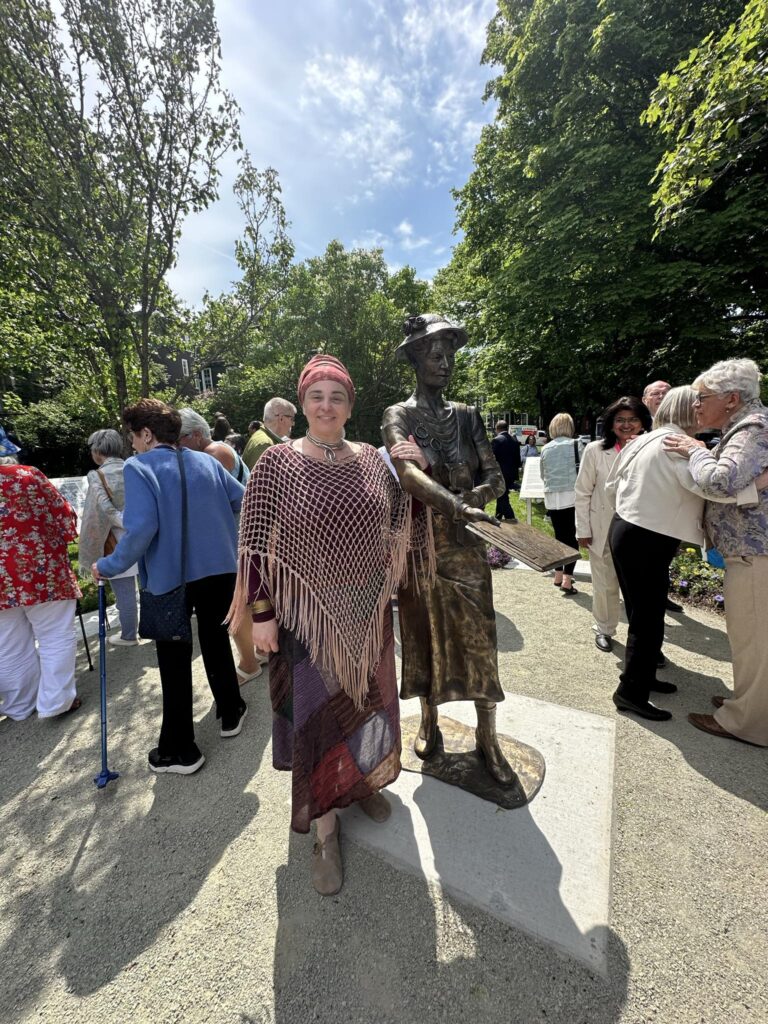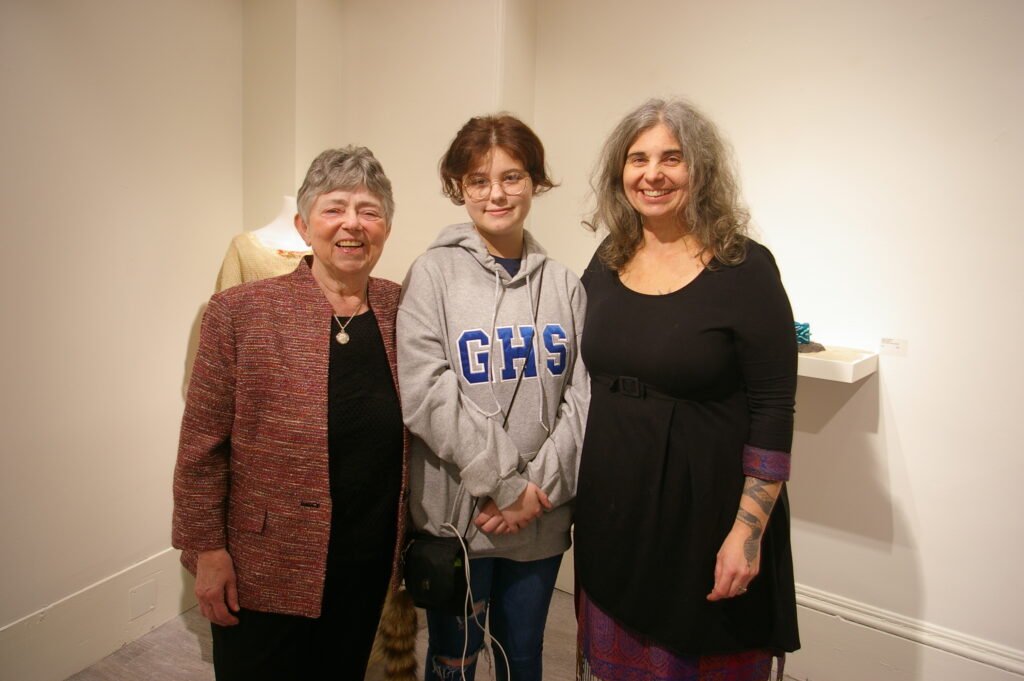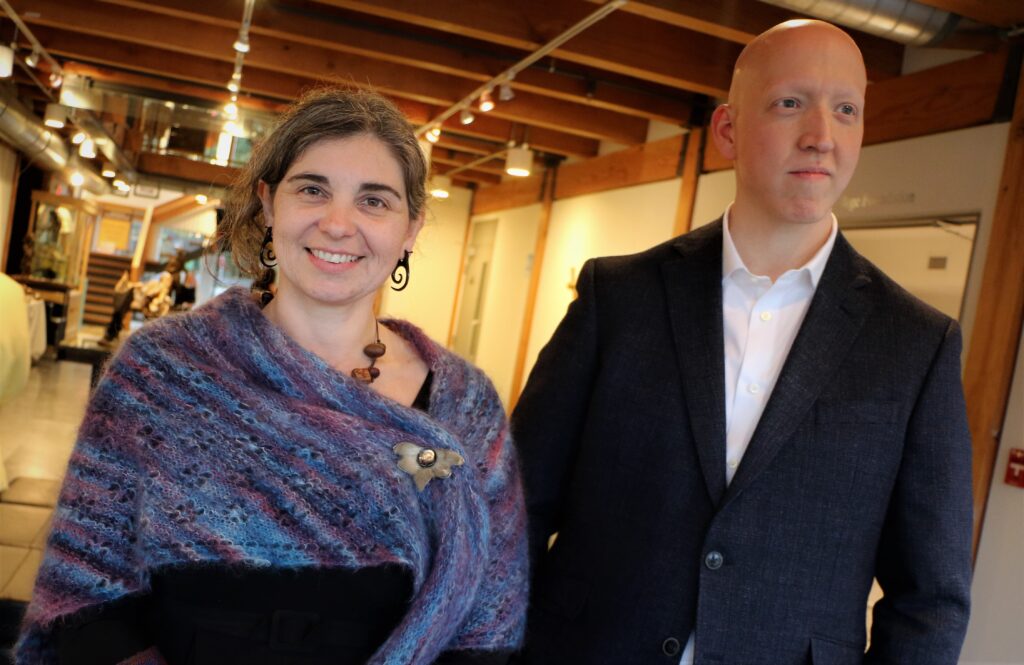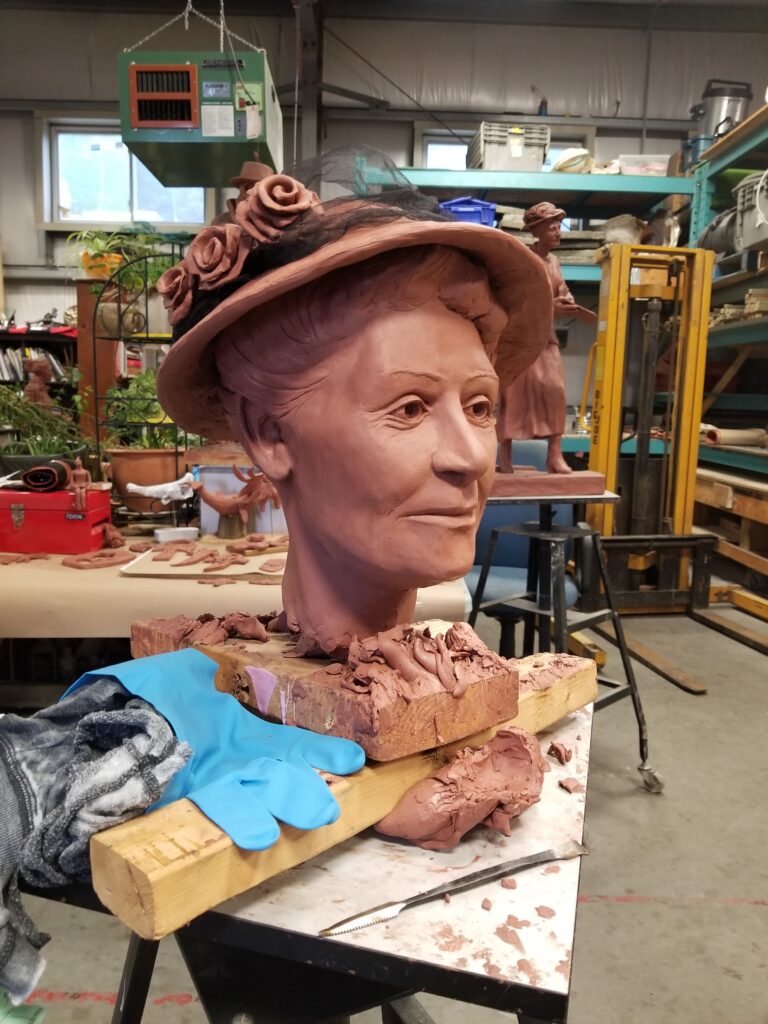How Sheila Coultas cast a tribute to women’s history—forging her own place in it
Amidst the lush foliage of Bannerman Park, an enthusiastic crowd gathers, starting a countdown that will mark a moment in history. At the countdown’s culmination, a black silk throw is gracefully swept away to reveal an exquisitely crafted, life-sized bronze statue of a woman eagerly holding out a clipboard. The crowd erupts with joyful applause. The statue has eyes that welcome you in yet quietly refuse to let you go. One hundred years after women earned the right to vote in our province, history was once again made in Newfoundland and Labrador.
The statue is of Armine Nutting Gosling, a suffragist who tirelessly petitioned for women’s right to vote in Newfoundland & Labrador over 100 years ago. Women at least 25 years of age on the island of Newfoundland gained the right to vote in 1925, and by 1946, the goal was achieved when Labradorians were able to cast their ballots for the first time.
The woman behind the work of art is sculptor Sheila Coultas, a multi-disciplinary artist and College of the North Atlantic (CNA) alum.
This historic unveiling is the first named statue of a woman in Newfoundland and Labrador crafted by a female sculptor.
It’s also the first named statue of a woman in St. John’s, by an artist of any gender.
“It was quite a thing to be asked to make the statue of Armine,” said Coultas. “A very heady experience, but it all seemed to make sense whichever way I looked at it. The project seemed tailor made for me.”
When Coultas’ sculpture of Gosling was unveiled this summer, it not only marked an historic first, but it also formed a bridge that connected generations of women’s advocacy.

A foundation in feminism
Sheila Coultas is no stranger to public advocacy. In fact, it’s in her blood.
Coultas’ mother is Frances Ennis, a well-known women’s rights advocate in the province.
“My mother and her friends were heavily involved in social justice, in particular women’s rights,” said Coultas. “I also spent much of my childhood in NDP campaign headquarters. The political structure in our family was oriented around labour unions and women’s rights.”
“Their work involved women finding their place in society and doing more male-dominated roles,” Coultas continued. “I guess that has a lot to do with my sister and me both becoming welders.”
Ennis is a recipient of the Governor General’s Award in Commemoration of the Persons Case, which honours outstanding individuals whose achievements and commitment have helped to advance equality for girls and women in Canada.
The award is named after a landmark 1929 court decision, achieved through the efforts of five Canadian women known as the “Famous Five,” which affirmed that women were legally recognized as “persons” and could fully participate in public and political life.
As if that wasn’t enough, Ennis is also a recipient of the Order of Newfoundland and Labrador, the province’s highest honour, which recognizes individuals who have demonstrated excellence in any field that benefits the residents of the province.
A path of her own
Make no mistake — Sheila Coultas did not ride on the coattails of her mother’s excellence. She has been forging her own legacy from the very beginning. Coultas took a self-driven, non-linear path, weaving together art and trade to arrive at her success.
In 1995, Sheila began her art education in textile studies at Cabot College (now CNA), where she learned about fibres and how to design with them. At the time, the program didn’t include garment construction, rather it focused on art history, drawing, knitting, weaving, embroidery, printing, and dying.
“It very much shaped my artistic skills,” she stated.
After graduation, Coultas spent two years working as a seamstress at Tony’s Tailor Shop in St. John’s. It was at that time she decided she wanted to try something new.
Sheila enrolled in the Women in Resource Development Corporation’s program Orientation to Trades and Technology (OTT), offered at CNA, which is a 16-week program designed to give women or gender-diverse individuals the opportunity to explore trade and technology sectors. She said she already knew that she wanted to study welding, even before enrolling.
After OTT, she went directly into CNA’s Welding Engineering Technician program. Unlike many who enrol in this program, Sheila’s intention was not to learn welding as a means to a career in the trades; she wanted to use welding as a way to express her art.
She knew she was on the right track when the renowned Newfoundland artist Gerald Squires, encouraged her.
“I knew that welding could be an artistic path, because Gerry Squires — who was a mentor of mine and a bit of a friend — was really excited when I told him I was going into it. He had done welding himself back in art school because he wanted to pursue sculpture.”
When asked what her classmates and instructors thought of her unique approach to her education in the trades, Coultas said, “I think it was appreciated that I was so open to new ideas outside of the career-oriented structure.”
“It helped me — and maybe even my classmates and instructors — to see that there are different ways of taking it,” she recalled.
“The instructors really found it fascinating when students would bring art and creativity into the welding program.”
And it’s not as if Coultas didn’t take her studies seriously.
Her academic prowess led her to win both the President’s Medal of Excellence and the Fry Family Foundation’s James Sellars Apprenticeship Award.
The former is given to the student in each program who attains the highest overall academic average. The latter is a financial award split up into two parts—one when the student graduates and starts their apprenticeship, and one if they go on to achieve journeyperson status.
Coultas said the President’s Medal was particularly special for her.
“I was in a relationship with an alcoholic, someone who was controlling and often tried to sabotage my progress. It was a really difficult time, but I got through it and still earned that award,” she said.
“That’s why it means so much to me.”

A brief diversion
Despite having intended to use welding in her art, Coultas did spend two years after graduation working as an apprentice welder in a traditional industrial setting.
“It really was male dominated — and that’s absolutely fine,” she recalled. “I got to learn what that’s like. It gave me a really good paycheque for a couple of years, but it wasn’t where I wanted to go, and that was made clear to me.”
On the bright side, Coultas said she did get to experiment with her art, despite working in that environment.
“There were long stretches of time where there wasn’t anything for the apprentices to do, so I would go through the scrap barrel and make sculptures. They didn’t like me doing that very much,” she laughed.
A chance encounter
After leaving her job as an apprentice welder, it just so happened that her father, a TV and film producer, was doing a documentary on Morgan MacDonald, a St. John’s-based sculptor and owner of the Newfoundland Bronze Foundry.
Since Sheila was now briefly unemployed, she thought she would tag along with her father to help out where she could.
Coultas overheard MacDonald’s frustration with the amount of welding he had to do.
She courageously piped up and said, “I can weld.”
MacDonald’s eyes lit up, replying with amazement and surprise, “You can weld?” he said. “I’m the only one here who can weld right now!”
That encounter led to two months of volunteer work, during which she learned everything she could from MacDonald. Coultas was an experienced welder, but making bronze sculptures first involved creating them in clay, a medium Coultas hadn’t had much experience with.
“Morgan is really excellent — such a patient teacher,” recalled Coultas.
“I learned a lot just watching him sculpt. I didn’t have much experience with clay or with the human figure, and you need to know so much about anatomy and structure. I learned it all from him,” she continued.
A two-month stint volunteering eventually turned into a 10-year career for Coultas at the Foundry.
“I felt like I won the jackpot when I got to the Foundry,” she exclaimed.
During her decade there, Coultas contributed to some of the province’s most significant public art projects. She worked alongside MacDonald on major commissions, including the Beothuk monument at the Confederation Building and a national RCMP memorial in Moncton. She also co-created a powerful exhibit on the Beothuk people, pairing her own birchbark paintings with MacDonald’s bronze sculptures.

An unfinished goal
While Coultas’ career at the Foundry was moving along in leaps and bounds, there was something that kept gnawing at the back of her mind—her welder’s Red Seal.
She was incredibly nervous about the exam because she had spent most of her time at the Foundry welding bronze, not structural steel.
“Welding bronze is actually quite easy,” explained Coultas. “So, I was kind of out of practice.”
“When I did my Red Seal practical exam, I actually shook the whole way through. I was so nervous,” she reflected.
“But I managed to come out on top. I didn’t have to redo anything, and I came out with a really good mark in the written exam.”.
Coultas credits the aforementioned James Sellars Award as the push she needed to get her journeyperson status.
“The process is quite difficult. It requires a lot of patience because you’re working in industry for four, sometimes five years just to get to the point where you can challenge the exam,” she explained.
“I was really pleased to get that award because it was the incentive that was meant to be for me to continue on.”
A serendipitous fit
In 2022, PerSIStence Theatre Company launched the fundraising project that would eventually pay for the commission of the Armine Nutting Gosling Statue.
At that time, Coultas was no longer working at the Foundry, but kept in close touch with MacDonald.
The theatre company had heard of the Newfoundland Bronze Foundry, loved the studio’s work, and wanted the project to be done there.
However, they had one stipulation.
“One day, Morgan got a call from Jenn Deon at PerSIStence Theatre,” said Coultas.
“Jenn always laughs about how bold she was, because she said to Morgan, ‘We really want your studio to do the work — but we want a woman to do it,” Coultas said, recalling Deon’s bold request with a laugh.
“And he said, ‘Well, I think I know just the person.’”

A monumental task
The process of making a life-sized bronze sculpture doesn’t happen overnight. In fact, it can take up to a year or more.
Coultas began by gathering references and doing some research on her subject. Unfortunately, there were only four historical photos of Gosling, and none of them showed her in profile (facing sideways). Coultas had to do some interpretation as to how Armine may have looked in her younger years.
Before starting the full-sized work, she created a clay maquette, or small-scale model that is used to visualize and plan the final work. She then submitted this to PerSIStence Theatre Company for final approval.
After getting approval, Coultas sculpted the full-scale statue in clay — then, counterintuitively, cut it into pieces. She applied layers of silicone and fiberglass to create detailed molds for each section. From these, wax replicas were made and dipped in a ceramic slurry to form a hard shell. When the ceramic was fired, the wax melted out, leaving a hollow mold. Molten bronze was then poured into the shell — which hardened into the final sculpture. The bronze sections were welded together and chased, a process of refining the surface to remove seams and perfect the details. The statue was then finished with a rich patina and installed downtown.
A long time coming
When the Armine Nutting Gosling statue was finally unveiled on June 18, 2025 in Bannerman Park in St. John’s, Sheila Coultas stood in the crowd with quiet certainty.
At that historic moment in time, Coultas was not merely the artist behind the work, but the woman uniquely shaped to tell this story — through her skilled artistry, her conviction, and the family legacy she carried.
By honouring Gosling, Coultas forged a powerful connection across generations, tying together a lineage of women who fought for change.
An epilogue
And then in true Sheila fashion, not two weeks later, she left — packed her bags and moved to South America.
“It really was a bit of a mic drop actually,” she said with a smirk on her face.
Now living in Paraguay, Coultas is taking time to relax and explore the local art scene.
She is revisiting her passion for painting and said that no matter what she does in South America, she wants to stay connected to the Foundry. She even joked about setting up her own “satellite” foundry in Paraguay.
She is also working on a book, titled The Divine Relationship, which explores how all the relationships in her life (both romantic and platonic) have shaped her into the person she has become.
“It has taken me on a spiritual journey,” she reflected.
And through that spiritual journey, Coultas discovered her dream project.
“I would love to do a bronze sculpture of Mary Magdalene,” she stated proudly. “That would really be a pinnacle for me in my career.”
Coultas said she wants to sculpt Magdalene not as the misrepresented figure of sin from traditional scripture, but as a spiritual equal and healer.
“They basically portrayed her as a prostitute, but she wasn’t,” Coultas said. “She was actually, in terms of ability and spiritual consciousness and awareness, on the same level as Jesus, and worked alongside him as a healer.”
Coultas sees the Magdalene project as part of a larger theme, one that explores the divine feminine, seeking to answer what it really means and exploring the effect that it has had on women throughout the ages. She sees it as a way to challenge old narratives.
That perspective shapes not just her art, but the advice she offers women entering the creative and trades fields today.
“It really is about following what you want to do, how you want your life to look. There’s no set way of navigating your specific lifeline,” said Coultas.
“If you want to be making lots of money in trades, going into trades is exactly what you should do. If it’s different, like my way of looking at the trades, then that’s what you ought to do,” she continued. “Industrial trades aren’t really geared toward artists, but they are a great way to learn and then apply those things that you’ve learned to your creative aspirations.”
“I wouldn’t change what I did, and I wouldn’t change how I did it. I would encourage anyone to learn however they see fit.”
Learn more about Sheila Coultas and the trailblazing women who helped shape Newfoundland and Labrador by tuning in to Raise Her Up: Celebrating a Century of Votes by Principals Productions’ Michelle Clemens and Bridget Ricketts. The documentary airs on NTV and streams on NTV+ on October 25, 2025, at 5:30 p.m. Newfoundland Time.


